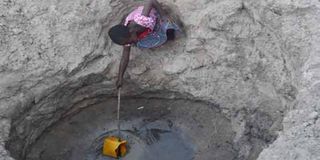Plan seeks to make Dar more habitable

A girl draws water for domestic use from a shallow well at Saranga Ward in Kinondoni District, Dar es Salaam, yesterday. The locality is among many areas in Dar es Salaam where clean and safe water is in short supply, forcing residents to either rely on unsafe sources or buy the commodity from vendors for up to Sh1,000 per 20 litres. PHOTO | SALIM SHAO
What you need to know:
The project that is funded by the World Bank covers all three districts in Dar es Salaam region and will be supervised by Ilala, Kinondoni and Temeke councils.
Dar es Salaam. The government is gearing up to start implementing the Dar es Salaam Metropolitan Development Project (DMDP) in a bid to improve infrastructure and proper land use.
The project that is funded by the World Bank covers all three districts in Dar es Salaam region and will be supervised by Ilala, Kinondoni and Temeke councils.
Dar es Salaam City Mayor Didas Masaburi said yesterday during a roundtable discussion on the future of Eastern African cities that seven feasibility studies have been carried out and the project would take off soon.
The World Bank provided credit worth $75 million from the International Development Association in July 2013 to improve the city’s infrastructure starting with the 2014/15 financial year.
The roundtable discussion brings together participants from Uganda, Kenya, Sweden, South Africa and Sudan. Somalia, the United Kingdom and France are also represented. The discussion will focus on the rise of city populations, the economic situation, waste management and climate change in the next 30 to 50 years.
According to Dr Masaburi, Dar es Salaam has experienced a high rate of growth of slums because the number of migrants from rural areas to the city is not in tandem with infrastructure and the government’s ability to provide social services.
The rise of slums in the city is said to be the result of poor knowledge of town planning and lack of funds. Land surveyors also do not have the equipment to do their job effectively.
“We are aware of the problem but the government does not have enough money to employ experts, buy the equipment required and ensure that all residential areas are surveyed,” Dr Masaburi said. “Since the government does not have enough funds to deal with all land-based issues, it has agreed to Public Private Partnership for the survey and sale of plots to wananchi.”
The government is also working at involving private investors in waste management and the transport sector. The focus now is on decongesting the city through the Bus Rapid Transit system in the city in an attempt to control traffic and enable the people to engage in economic activities effectively.
Safety and security are also crucial issues that Dr Masaburi says his office is focusing on, with a camera system to be installed in several parts of the city.
“We are looking forward to installing cameras in all parking yards and ensuring the city is safe,” Dr Masaburi explained. “This will help boost the number of investors, tourists and traders from other parts of the world--as long as the city is safe and has reliable security systems.”
The Director of Mistra Urban Futures from Gothenburg, Sweden, Prof David Simon, advised cities in Eastern Africa to join Cities Alliance, a global partnership targeting urban poverty reduction and promoting the role of cities in sustainable development.
Most Eastern African cities face challenges brought about by outdated planning, lack of strategic metropolitan agencies and lack of transparency. According to Prof Simon, East African cities must work hard to ensure proper planning in the next three decades.
Earlier, Zanzibar’s Second Vice President, Ambassador Seif Ali Idd, told participants that city planning and improvement of infrastructure must go hand in hand with improving rural lives in order to help balance the population in both rural and urban areas. “If we fail to balance,” he added, “villagers will continue moving to cities in search of better lives.”
It is estimated that half of Tanzania’s population will be living in urban areas by 2030. The government has set a target of halving the urban dwellings in poor condition by 2025 and says it is working to boost access to credit for urban real estate development.
This is expected to boost the quality of housing, cut the cost of housing in urban and rural areas and support better mortgages.
According to the governor of Khartoum City, Dr Abdelrahman Al Khidir, rapid population growth and city expansion are some of the major challenges for African cities. “This has led to a rise in slums and poor infrastructure.”



